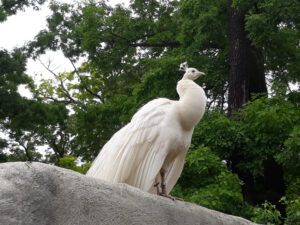Founded in 1889, Zoo Atlanta began when businessman George V. Gress bought a bankrupt traveling circus. He donated the circus animals to the city of Atlanta, which decided to place the animals in Grant Park, where the zoo still lies today.
Zoo Atlanta regularly appears on “top” lists of zoos in the United States to visit, and its location makes it an accessible destination for vacationers looking for a top-notch zoo.
When, then, is the ideal time to go to Zoo Atlanta? What are the seven most amazing animals to see when you get there? Let’s find out.
Ideal Days and Times to Go to Zoo Atlanta

Atlanta’s October temperatures are 72 degrees Fahrenheit for an average high and 54 degrees Fahrenheit for an average low.
©Sean Pavone/Shutterstock.com
As far as time of day and day of the week, most zoos are similar as far as the optimum time to visit. Zoo crowds are lowest during weekdays, with Monday, Tuesday, and Wednesday being the least crowded days to visit. Early-morning visits are ideal, especially for Zoo Atlanta. For most of the year, midday and early afternoons can be quite warm and humid in “Hot ‘Lanta.”
Not only are early-morning visits best for humans, they are best for the animals, too. In general, animals are the most active early in the morning and late at night. Therefore, getting to Zoo Atlanta when it opens at 9:00 a.m. is your best bet. However, the zoo offers a Twilight Trek from 6:30 p.m. to 9:00 p.m. nine times per year. This Twighlight Trek offers visitors night-vision technology to enable viewing animals not normally seen during the day and the nocturnal behavior of all animals.
Zoo Atlanta offers after-dark experiences a few times per year. Some of these include Boo at the Zoo in October, Illuminights at the Zoo from November through January, Cookies with Santa in early December, and the zoo’s annual fundraising gala in May.
Ideal Time of Year to Go to Zoo Atlanta
What time of year should you visit the zoo? Both autumn and spring are the best seasons to visit the zoo, but winter is a great time to visit as well. Atlanta’s daily temperature in October is 72 °F for the average high and 54 °F for the average low. Similarly, in April, Atlanta enjoys a mild average high of 73 °F and an average low of 49 °F.
Don’t rule out the winter months, though, because Atlanta’s winters are moderate. While Atlanta receives its share of cold spells, its average January daytime temperatures rest in the mid-50s, a crisp but comfortable climate. Additionally, winter months bring fewer crowds, enabling visitors to enjoy the zoo more autonomously.
Amazing Animals to See at Zoo Atlanta
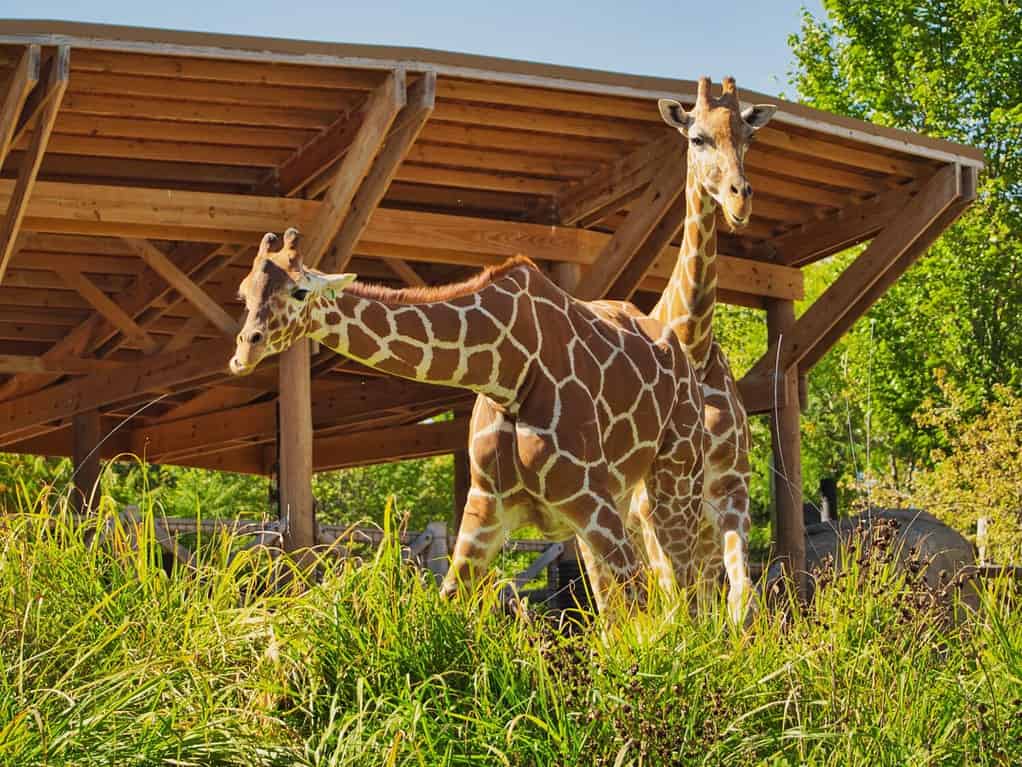
Giraffes are a top attraction at almost every zoo.
©Wirestock Creators/Shutterstock.com
Seeking a world “where wildlife and humans flourish together,” Zoo Atlanta’s mission focuses on humanely maintaining animal habitats through conservation, education, research, and captivating in-person experiences. The zoo contains over 1,300 animals representing over 220 species from around the globe, so which are the must-see of these amazing animals?
1. African Elephant
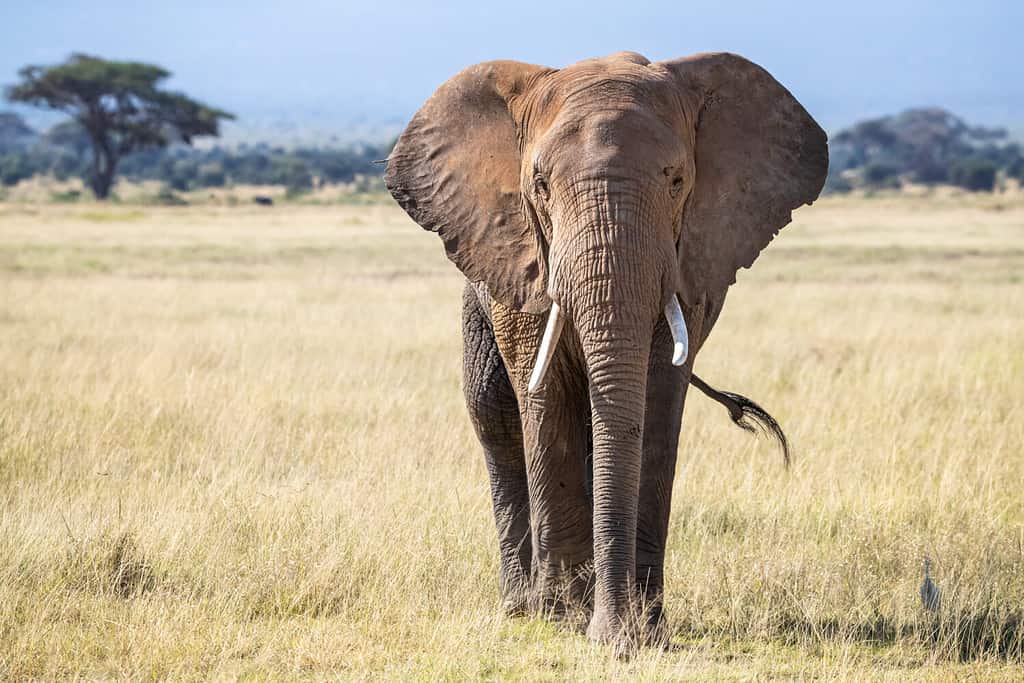
African elephants are fascinating to experience in person.
©Jane Rix/Shutterstock.com
In 2019, the zoo moved its African elephants to their new home in its African Savanna. This new space tripled the size for the elephants to roam and is designed to specifically replicate the elephants’ natural habitat.
The largest land animal in the world, African elephants are an ever-popular feature at Zoo Atlanta. Weighing in at 6,600-13,000 pounds, these magnificent beasts are usually peaceful but become aggressive during mating season, while defending their young, or when they are provoked, sick, or injured.
Living in family groups heralded by a female matriarch, African elephants lead their wards, teaching survival skills and social norms for decades. Elephants detect sound through their front feet which can sense low-frequencies. They can communicate via the same low transmission sound across miles of acreage.
Zoo Atlanta offers a Wild Encounter Experience where you are partnered with a zoo expert for insider guidance. Patrons get a behind-the-scenes experience where they learn firsthand how elephants are cared for at the zoo. If you choose this add-on, you also get to hand-feed one of the zoo’s awesome African elephants.
2. Giant Panda Bear

Giant pandas’ lovable persona makes them a zoo favorite.
©Hung Chung Chih/Shutterstock.com
Zoo Atlanta has been a proud guardian of giant pandas since 1999, when Lun Lun and Yang Yang, a pair of giant pandas, arrived on loan from China. Since 2006, the couple has enjoyed producing seven cubs, some of which were relocated back to China. They have a set of twins who still live at the zoo. Per the loan agreement with China, twins Ya Lun and Xi Lun are scheduled to transfer to China in early 2024.
Weighing up to 550 pounds, the affable giant panda enjoys a long life of 20-35 years. Found in the central and western China mountains, giant pandas are one of the rarest and most recognizable animals in the world. Giant pandas distinguish themselves from other bear species in that they do not hibernate, and they rely almost solely on a vegetarian diet.
Generally solitary animals, giant pandas mainly eat bamboo leaves, shoots, and stems. Because bamboo contains little nutrition, giants regularly munch on these treats between 12 and 15 hours a day. Although pandas spend much time sitting down — and eating — they are adept at both climbing trees and swimming.
Similar to the elephant wild encounter experience, Zoo Atlanta offers a similar behind-the-scenes adventure enabling visitors to explore the giant panda on a more personal level.
3. Western Lowland Gorilla

Zoo Atlanta has one of the largest populations of western lowland gorillas in North America.
©Philippe Clement/Shutterstock.com
The zoo is renowned for its western lowland gorillas, an overwhelming favorite of zoo patrons. The gorillas’ storied history at Zoo Atlanta chiefly involves Willie B., a gorilla who lived indoors for the first 29 years of his life. When Zoo Atlanta opened the Ford African Rain Forest, approximately 25,000 people attended the opening and witnessed Willie B.’s foray into his ample new outdoor habitat. The forest would launch the home of a new group of gorillas including the mothers of Willie B.’s offspring. Willie B. died in 2000, and the zoo erected a memorial to this gorilla outside the Ford African Rain Forest.
With an average lifespan of 35-50 years, the western lowland gorilla grows to over 400 pounds in many cases. A highly intelligent animal, the western lowland can run up to 25 miles per hour. They possess the lowest number of family members of any other gorilla species (with an average of four to eight members compared with up to 50 for other gorilla groups).
Visitors continue to flock to the almost two-acre rainforest to view Willie B.’s grandchildren. To take the gorilla experience further, Zoo Atlanta opened Gorilla Trek, a 360° virtual experience theater that allows visitors to virtually explore Rwanda and have up-close encounters with these breathtaking beasts.
4. African Lion

The majestic African
lion
is an awe-inspiring king of the grasslands and the zoo.
©iStock.com/Shawn Levin
Zoo Atlanta partnered with Lion Guardians to devise long-term arrangements for humans and lions to coexist. They recruit and train young Masasai to intervene with those attempting to poach African lions. Their goal is to eventually reduce conflict between lions and humans. The zoo’s African lions live in the Quarters for Conservation champions, and brothers Azizi, Hondo, and Hatari are now fully-grown male African lions visitors can view daily.
Carnivores, the African lion lives up to 15 years and grows up to 550 pounds. They are the largest cats in Africa, and while they are solitary hunters, they live sociable lives within their pride, which is made up of 80% females.
With the ability to run up to 37 miles per hour, African lions prey on zebras, antelopes, and other hoofed animals. Animals can be alerted by the lion’s mighty roar, which can be heard up to five miles away. Other than the coldest and rainiest days in Atlanta, visitors can see the lions throughout the year.
5. Ring-tailed Lemur
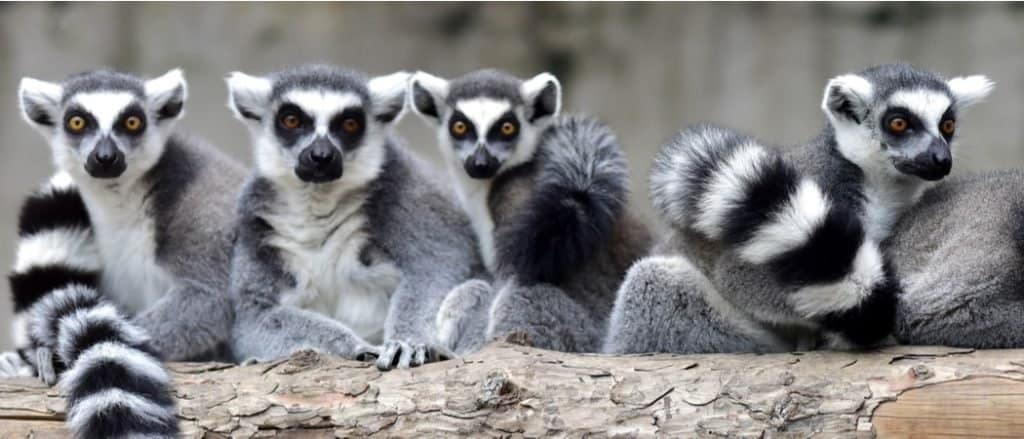
The ring-tailed lemur hails from enigmatic Madagascar.
©Wang LiQiang/Shutterstock.com
The ring-tailed lemur is one of three species of lemurs living in The Living Treehouse area of Zoo Atlanta. The other two are the black-and-white ruffled lemurs and the crowned lemurs.
Lemurs hail from the diminutive island of Madagascar; in fact, this island nation is the only place lemurs are found. Established mainly in rainforests and scrublands, ring-tailed lemurs are primates with long, thin tails.
Both male and female ring-tailed lemurs are small, weighing between five and eight pounds. They mainly live in trees due to their grasping ability, and they are one of the few species that live in a matriarchal society, with a single female leading each troop. This alpha female resides with a group her entire life while males, conversely, migrate among groups.
Zoo Atlanta features a Lemur Wild Encounter where patrons can meet and feed these Madagascan inhabitants. The Lemur Wild Encounter runs from the end of March to the end of October, on Fridays, Saturdays, and Sundays at 11:00 a.m.
6. Bornean Orangutan
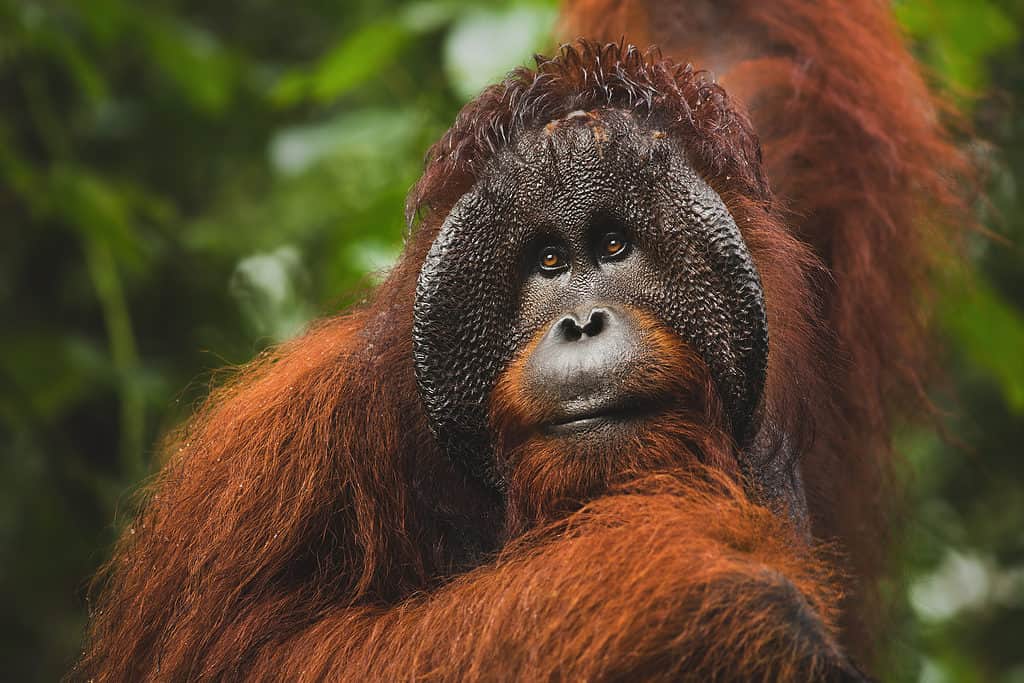
Orangutans hail only from the rainforests of Borneo and Sumatra.
©Marketa Myskova/Shutterstock.com
Another animal that Zoo Atlanta has invested much time and effort in conserving is the Bornean orangutan, the highly intelligent red ape from the third-largest island of Borneo. The Borneo Orangutan Survival Foundation (BOSF) serves to maintain, restore, and protect the rainforests that have been decimated by the global palm oil industry. The industry’s clear-cutting has continued to endanger orangutans by removing their habitat and separating the young from their mothers.
Zoo Atlanta partners with BOSF by adopting orangutans, including four Bornean and six Sumatran orangutans to its Orangutan Habitat area. Satu, which means “first,” was the first Bornean orangutan born at Zoo Atlanta in 2003.
The Bornean orangutan differs from other ape species in that it lives a solitary life rather than in social groups. Possessing complex cognitive and spatial skills, Bornean orangutans are adept at puzzles and situations that involve recalling and matching objects, sequencing, or memorization. A Bornean’s lifespan averages 30 – 40 years, but in a protected environment, they can live to 60.
At Zoo Atlanta, the Bornean orangutans forage throughout the Asian Forest habitat, either outside or snuggled inside in their indoor nests. In September 2023, the zoo welcomed Nangka, a four-month-old male Sumatran orangutan. Nangka was subsequently adopted by Madu, a 40-year-old female who has adopted four other orangutan babies over the past 20 years.
7. Laughing Kookaburra
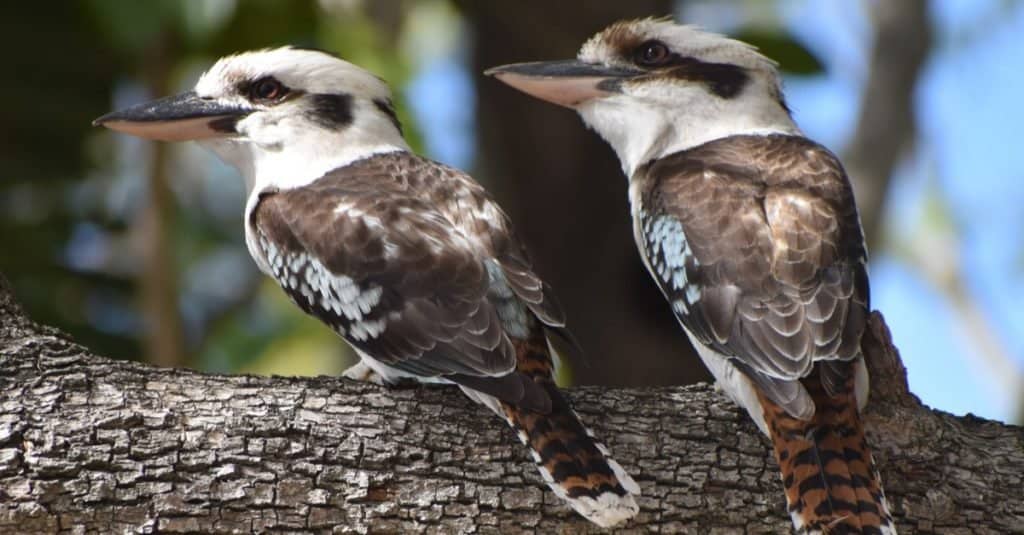
Kookaburras are known for their call, which sounds like laughter.
©MPRshots/Shutterstock.com
One of four kookaburra species, the laughing kookaburra is a Zoo Atlanta favorite in part due to its cacophonous call and “laughter.” This bird, a subspecies of the kingfisher breed, hails from Australia with smaller populations in New Zealand and New Guinea.
Living in communal flocks, the laughing kookaburra thrives in both native and human-developed habitats. They are most active at dusk and dawn when they claim their territory with their cackling “laughs,” and they generally tolerate human interaction well. This diurnal bird sleeps approximately 12 hours at night and is usually found in eucalyptus trees, also known as old gum trees.
These seven amazing animals are only the proverbial tip of the iceberg of what you can discover at Zoo Atlanta. With 1,300 animals representing 220 species from around the globe, Zoo Atlanta is a veritable delight for anyone who wants a closer look at these fascinating animals.
The photo featured at the top of this post is © Rob Hainer/Shutterstock.com
Thank you for reading! Have some feedback for us? Contact the AZ Animals editorial team.





